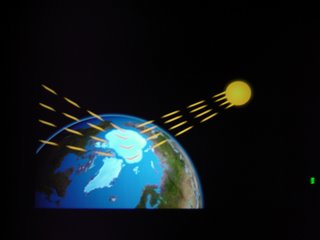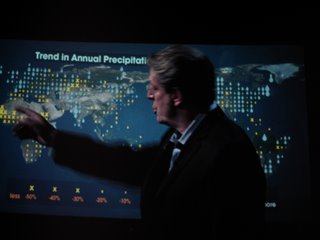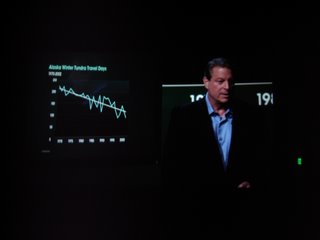An Inconvenient Truth
 I saw the Al Gore movie, "An Inconvenient Truth" today and was very impressed. In documentary form, it follows the former vice president of the United States on a worldwide tour as he gives a slideshow presentation on what is defined as our climate crisis.
I saw the Al Gore movie, "An Inconvenient Truth" today and was very impressed. In documentary form, it follows the former vice president of the United States on a worldwide tour as he gives a slideshow presentation on what is defined as our climate crisis.Gore's movie suggests that unless we act now, the world may face a global environmental crisis in ten years. Epic destruction could include floods, droughts, and heat waves that are worse than any other we've ever experienced.
One thing I learned was that when the Northern Hemisphere is experiencing summer, the planet absorbs more heat (and is therefore more hot) than when it experiences winter. The reason is simple: there is more land mass in the Northern Hemisphere than in the Southern. Ice is part of that delicate balance, however. The more it melts, the more potential for things to get very much out of control.
 He makes his case in stunning detail, using charts, graphs, photos, and animated cartoons to make his point. What may be the biggest surprise of the movie is that Gore manages to make streams of data interesting and compelling. He also explains difficult concepts well, and puts things into their proper context (as far as I could tell).
He makes his case in stunning detail, using charts, graphs, photos, and animated cartoons to make his point. What may be the biggest surprise of the movie is that Gore manages to make streams of data interesting and compelling. He also explains difficult concepts well, and puts things into their proper context (as far as I could tell).This graphic demonstrates how individual components of the Earth affect global temperatures, and is supported by various other concepts. Ice tends to reflect sunlight, whereas water absorbs it. If our environment traps more heat into our atmosphere, as most environmentalists say we are doing due to our habits as a species, it causes the ice at the polar caps to melt. This means that each year there is less ice to reflect sunlight hitting our planet, and more heat being absorbed into our globe (and the problem compounds further as the water gets hotter). When sunlight hits water, some of it turns into water vapor...and that turns into precipitation (or rain and snow).
 Annual precipitation is very much on the rise. Every time Gore shows historical records dating back thousands -- or even millions -- of years, our current numbers are literally off the charts. For instance, 2005 was the worst storm season on record. One Website states that the ten hottest years on record have all taken place since 1990.
Annual precipitation is very much on the rise. Every time Gore shows historical records dating back thousands -- or even millions -- of years, our current numbers are literally off the charts. For instance, 2005 was the worst storm season on record. One Website states that the ten hottest years on record have all taken place since 1990.The number of Category 4 and 5 hurricanes has almost doubled in the last 30 years. How does water vapor fit into that? Hurricanes feed off of hot water vapor. The more that exists in a given area, the stronger the storm. It's possible that Hurricane Katrina, which devastated the Gulf Coast region, will be remembered as a "tipping point" for global warming.
Both the movie and Popular Science, in its July 2006 issue, shows two photos of Glacier National Park: one in the summer of 1938 covered in ice and another in the summer of 2005 almost empty of it. The magazine reports that the ice has shrunk by 70 percent in the past century or so.
 The movie's message is that global warming is not just a scientific matter, nor is it just a political one: our role in the affect of our planet's weather is a moral issue. We are hurting the planet and we are hurting ourselves. We must understand this and act.
The movie's message is that global warming is not just a scientific matter, nor is it just a political one: our role in the affect of our planet's weather is a moral issue. We are hurting the planet and we are hurting ourselves. We must understand this and act.The Website that promotes the movie lists some interesting facts to support the theory that mankind's excessive generation of carbon dioxide is worsening global warming:
- Malaria has spread to higher altitudes in places like the Colombian Andes, 7,000 feet above sea level.
- The flow of ice from glaciers in Greenland has more than doubled over the past decade.
- At least 279 species of plants and animals are already responding to global warming, moving closer to the poles.
 The same Website predicts that:
The same Website predicts that:- Deaths from global warming will double in just 25 years -- to 300,000 people a year.
- Global sea levels could rise by more than 20 feet with the loss of shelf ice in Greenland and Antarctica, devastating coastal areas worldwide.
- Heat waves will be more frequent and more intense.
- Droughts and wildfires will occur more often.
- The Arctic Ocean could be ice free in summer by 2050.
- More than a million species worldwide could be driven to extinction by 2050.
 If sea levels rise as they are estimated to, Manhattan's World Trade Center Memorial Site (if they ever build anything on it) will be flooded. Doom and gloom represent the end of the movie, just before a call to action.
If sea levels rise as they are estimated to, Manhattan's World Trade Center Memorial Site (if they ever build anything on it) will be flooded. Doom and gloom represent the end of the movie, just before a call to action.According to the movie Website, the "average American generates about 15,000 pounds of carbon dioxide every year from personal transportation, home energy use and from the energy used to produce all of the products and services we consume." The Website offers options on how we can reduce that amount.
The crisis of Global Warming is not without its critics. The movie mixes real images with simulated ones, and it is difficult to know which is which at times. IMDB points out that the "continuous shot of the Ocean Surface to the Ice Shelf is presented to the audience as actual footage or Antarctica, when really it is a CGI shot taken from the opening credits of the movie 'The Day After Tomorrow'."
I am not a scientist so I cannot say if any of this is true. What I can say, however, is that the movie and the former Vice President make for a very compelling case. They seem to tie their loose ends up very well, and explain how things happen and may get worse. It is a very convincing argument for global warming, one that any serious intellectual should expose themselves to. I would be temped to see someone refute this movie on a point-by-point basis, doing so in a way that is equally as thorough and compelling.
As for me, the movie forced me to act right away. The air conditioning in the theater was up so high I complained to the manager. After seeing a movie about carbon emissions and its effect on the environment in a room nearly freezing from an air conditioner, I told the theater manager that "the irony of it could not escape me."
He said he would turn it down. It was my first post-movie environmental victory.
UPDATES:
The Los Angeles Times recently reported on the affect of global warming on Greenland:
Should all of the ice sheet ever thaw, the meltwater could raise sea level 21 feet and swamp the world’s coastal cities, home to a billion people. It would cause higher tides, generate more powerful storm surges and, by altering ocean currents, drastically disrupt the global climate.
The article continues:
By all accounts, the glaciers of Greenland are melting twice as fast as they were five years ago, even as the ice sheets of Antarctica — the world’s largest reservoir of fresh water — also are shrinking, researchers at NASA’s Jet Propulsion Laboratory and the University of Kansas reported in February.President Bush admits that Global Warming is happening.
RELATED LINKS:
The Earth is the Hottest It's Been Since Jesus Walked the Earth The report is a matter of dispute.
Rotten Tomatoes aggregates reviews of An Inconvenient Truth
An Inconvienent Truth trailer on Apple.com
The Vote Solar Iniative
Conservation International on Climate Change
The Climate Crisis Blog
Science Has Spoken, Global Warming Is A Myth
The Global Warming Myth and Its Selfish Defenders
What Is Global Warming?
The Pentagon Sounds the Alarm on Global Warming
Don't Ignore "An Inconvenient Truth"
An Inconvenient Truth...Because It's Lie



0 Comments:
Post a Comment
|<< Home